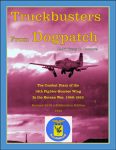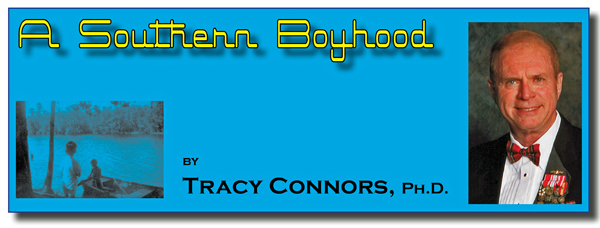I stopped and leaned up against the stuccoed square white columns of the school’s front portico. The realization that I was contemplating a deliberate act of rebellion…of disobedience…of self-protection…of sinning, at least as I understood the term at the time…made it imperative that I stop for a moment to get control over my rubbery legs.
After another minute or so…it felt like a week…I knew that my continued…at least temporarily continued…existence depended on the note “getting lost” on the way home.
As I stepped onto the semi circular driveway in front of the school and then set off across the white sand that was the playground, I reached for The Note. Trying to “walk and chew gum at the same time,” I plodded fatalistically across the sand, pulled the note out of my pocket, and slowly, deliberately tore it into the smallest pieces I could manage.
No two determined hands ever reduced a piece of paper closer to molecular level than did mine as I made my way home, dazed and confused by the events of the last hour and a half.
As the the microscopic tufts of the former note fluttered to the sand and were whisked away by the chilling gusts of October, they marked the end of my “childhood” in many ways. Just that morning I had been a carefree kid just starting the First Grade; now, I was almost a convicted felon who was choosing self-preservation over “doing the right thing.”
Right there, in the sand lot of North Shore Elementary School, of an autumn afternoon in nineteen hundred and forty five, I sinned for the first time…not by accident, not by chance, but deliberately.
As I tore up that note I knew that I was crossing into new and uncharted territory.
For weeks afterward, I waited for the sword of doom to descend once more. I waited for Mrs. Stephens to summon me again with those dreaded words, “The Principal wants to see you—in his office–again.”
I pictured what it would be like to enter his large, cold office to face him—and my parents—as he called me to account for the missing note. That “picture” was bleak, indeed!
But the call never came. Without the help of a computer program, perhaps, the note and its summons were forgotten. Slowly, it became clear that this coward would live to fight again, some other day.
And somehow, I finished the First Grade with no more visits to The Office. In fact, it was my only trip to The Office the entire seven years I attended North Shore.
Once was enough for this six-year old sinner…with the blighted life and uncertain future!
© Copyright 2019 BelleAire Press
Other works by Dr. Connors…
Baited Trap, the Ambush of Mission 1890
Now Available As E-Pub

Baited Trap, The Ambush of Mission 1890 is the story of helicopter rescue Mission 1890, one of the most heroic—and costly—air rescues of the Korean War. This harrowing Air Force-Navy mission is explained in compelling detail, creating a detailed personal account of what five incredibly brave and determined Air Force and Navy airmen achieved on June 25, 1952 in the infamous “Iron Triangle.”
The Korean War’s Greatest Love Story
Baited Trap is much more than a heroic war story from the “forgotten war.” It is also the Korean War’s greatest love story, following Wayne and Della Lear, Bobby Holloway, Ron Eaton and Dolly Sharp, and Frankie and Archie Connors as they tried to put their lives and families together even as the Korean War was reaching out to engulf them.
Truckbusters From Dogpatch: the Combat Diary of the 18th Fighter-Bomber Wing in the Korean War, 1950-1953 (SB)

Truckbusters from Dogpatch is the most comprehensive Korean War unit history yet prepared–over 700 pages summarizing squadron histories and first person accounts—and includes over 1,000 never before published photographs and images, highlighted by the 8 ½ x 11-inch format.
Arguably, Truckbusters From Dogpatch is the most authoritative unit history ever prepared on the Korean War. In addition to consulting formerly classified squadron histories filed monthly throughout the conflict, the author was in touch with hundreds of veterans of the 18th—pilots and ground crew—whose personal recollections add vivid detail and emotion to the facts recounted in the official documents.
On its way…
 We are delighted to report that the long-awaited e-Publication edition of Truckbusters from Dogpatch is now available. The huge, 700+ page, 1,000 image original print edition is being updated and organized into four e-Publications, each covering a year of combat. With the advantages of e-Publication, color images will add more depth and immediacy. Hyperlinks will connect readers with additional information and resources. The e-Publication format will allow convenient, portable reading from iPads and similar devices. For more information on how to download Truckbusters, 1950…
We are delighted to report that the long-awaited e-Publication edition of Truckbusters from Dogpatch is now available. The huge, 700+ page, 1,000 image original print edition is being updated and organized into four e-Publications, each covering a year of combat. With the advantages of e-Publication, color images will add more depth and immediacy. Hyperlinks will connect readers with additional information and resources. The e-Publication format will allow convenient, portable reading from iPads and similar devices. For more information on how to download Truckbusters, 1950…
The first e-Publication edition covers the 18th Wing’s 1950 combat operations. We will bring you regular updates on this page about the launch date for Truckbusters, 1951.
Recent Log Entries by CAPT Connors…
Carrier Captain’s Night Orders: “Call Me…”
After reading these Night Orders you can better appreciate what training, attention to duty, and vigilance was required by underway watchstanders in those days. What has changed since then that has resulted in the recent tragic collisions between U.S. Navy ships and other vessels?
“We do it all!” (USS Saipan LHA-2 motto)
Saipan CO, CAPT Jack Renard, was not exaggerating when he noted that “without exception, SAIPAN is the most versatile instrument of peace or war on the seas today.” Like its motto pointed out, SAIPAN could do it all.
In Dire Straits of Gibraltar
I had never taken the ship (aircraft carrier F. D. ROOSEVELT) through the Straits before as the OOD. Now I was expected to do so while the rest of the ship—including the Captain—was fast asleep.
U.S. Navy and back to the future Star Power
The reliance today by U.S. Navy afloat units on satellites and highly complex electronics, all of which are vulnerable to compromise or destruction by an enemy, can also leave us highly vulnerable, particularly if our ships and Surface Warfare Officers are not trained in more traditional methods of navigation and seamanship.
Losing satellites could badly compromise or eliminate satellite navigation. Funny, I trusted the star fixes, but the GPS readings that came later, were suspect. As this Log Entry points out, satellites are vulnerable. They can be hacked or “taken out” in a variety of ways.
But with training, a sextant, the right tables and a handful of stars or a noon day sun, the cosmos will tell you where you are on planet Earth.
Soot, as a weapon? Recalling the Mediterranean Cold War in the Sixties
The watch team cheered, we even heard cheering from PriFly aft of our level. The Captain was happy, the bridge watch team was ecstatic. The Russians on our tail? Not so much! Main Control had “gotten into the War,” and I wrote in the ROOSEVELT’s deck log: “Blew tubes at 1430.”
The In-Port Watch on a U.S. Navy aircraft carrier in the Sixties
Any questions?”
“Not that I can think of,” I replied, then added the required legal response: “I relieve you Sir.”
The fateful words are spoken. From this point on, anything that happens on this watch will be my responsibility.
“Very well, I stand relieved. Quartermaster, LTJG Connors has the deck,” the now off-watch OOD announced to the Watch Team.
I, in turn, step back out onto the quarterdeck to take a look around to see if there are any boats headed towards the ship.
The air is very cold, but refreshing, in small doses.
The far off boats of Cannes, swing in the breeze.
At this distance, the beautiful city rolls itself like a white wave, far into the hills. On the distant horizon, covers the mountains like a picture post card.
Memories of the Fru Dee Roo
When the USS Franklin D. Roosevelt (CV A-42) was towed toward the oblivion of the scrap yard in 1978, she consisted of some 65,000 tons of obsolete steel and equipment–but she left many more tons of memories with the tens of thousands of Navy men who had served aboard her during her 32 years of commissioned service.
The “Rosy” or “Fru Dee Roo” or “Rusty Bucket” to those of us who alternately cussed her amongst ourselves and who fought for her honor with outsiders, was more than just a ship. She was home for some 4,000 men–a floating “town” some 1,000 feet long with over 500 miles of wiring, 150 television receivers, 111 storerooms where some 81,000 items were kept in readiness, and with 12 oil-fired steam boilers that drove it at speeds up to 32 knots. A bit of a “gas hog,” the ship’s boilers burned some four million gallons of fuel per month on average. This “town” carried over 70 warplanes of many types and could launch them at a rate of two per minute.
We were “the stick” in case the “talk softly” part was not successful.
What The Hell Flag Signal
The day the ROOSEVELT got the What the Hell Flag Signal. As the OOD, you knew you had really screwed things up when an oiler gave you the “What the Hell” Flag Signal.
On this afternoon, as we were making our high speed approach on the oiler, the Captain suddenly announced that he had the conn (was maneuvering the ship himself), then announced that Commander “Neversail” had the conn. I was amazed. I assumed that he wanted the new Navigator to get some experience, but to actually let him maneuver the ship (with the Captain making “recommendations” while standing right beside him), was risky as we were barreling down on the unsuspecting oiler. “Things” didn’t go well, as they say.
